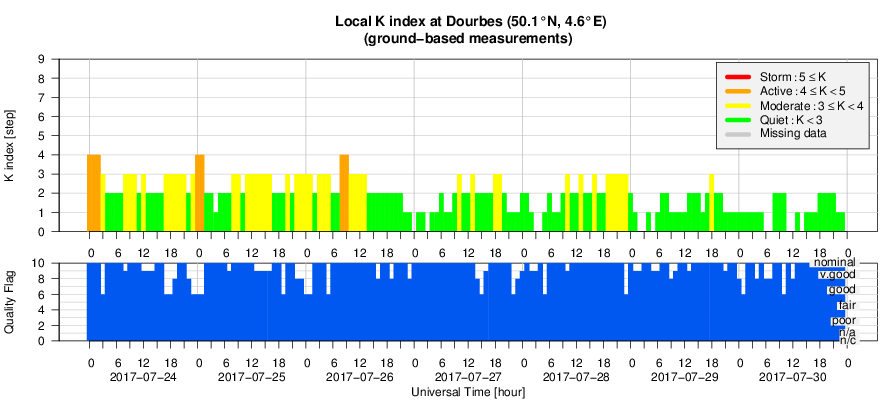- Table of Content
- 1.Night of the (...
- 2.Review of sola...
- 3.PROBA2 Observa...
- 4.The Internatio...
- 5.Review of geom...
- 6.Geomagnetic Ob...
- 7.SIDC Space Wea...
- 8.Review of iono...
- 9.Future Events
2. Review of solar activity
3. PROBA2 Observations (24 Jul 2017 - 30 Jul 2017)
4. The International Sunspot Number
5. Review of geomagnetic activity
6. Geomagnetic Observations at Dourbes (24 Jul 2017 - 30 Jul 2017)
7. SIDC Space Weather Briefing
8. Review of ionospheric activity (24 Jul 2017 - 30 Jul 2017)
9. Future Events
Night of the (shooting) Stars 2017
On 9 August from 21:30 till 24:00, the Royal Observatory opens its premises to the broad public to observe the night sky. Amateur astronomers will bring their telescopes to allow the participants a view on the stars from between the prestigious domes of the Observatory. There will also be astronomy lectures and a visit to one of the telescope domes.
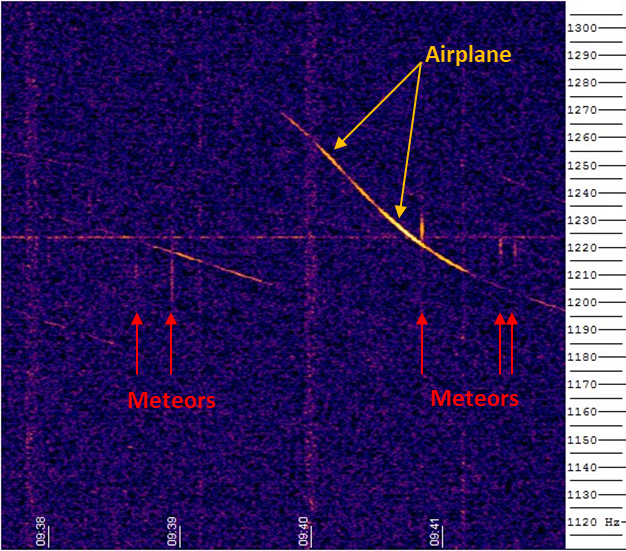
The timing of the event was chosen to be close to the maximum of the Perseids, one of the most prolific meteor showers of the year. Meteors, also called shooting stars, are tiny dust particles that quickly burn up in the Earth's atmosphere leaving a streak of light visible for only a fraction of a second. Even in case of cloudy weather, the meteors can still be observed by watching the radio signal they produce. The radio receiver from the Belgian RAdio Meteor Stations network (BRAMS; http://brams.aeronomie.be/ ) located on the domain will catch the radio signals that mark the presence of the meteors. The project has developed into a full Citizen Science project (https://www.zooniverse.org/projects/zooniverse/radio-meteor-zoo ) where you can actually make a very important contribution to science by simply counting meteors!
It is well known that strong solar flares can affect the number of recorded radio signals from meteors, but this happens only during the daylight (sunlit) hours. See the example below (the effect from a very strong X-class flare) and this news item at http://www.stce.be/news/222/welcome.html for more information. During the strong solar eruption of 14 July 2000 that occurred around 10:30UT that day, Dutch observers could not count radio meteors for 1.5 hours due to all the radio noise!
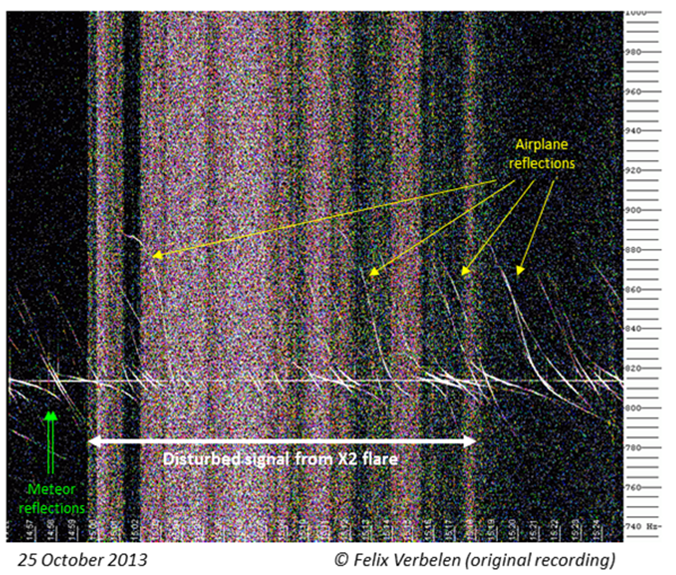
The "Night of the Stars" is organized by the Royal Observatory of Belgium and the Planetarium (http://planetarium.be/frontpage.php ), in collaboration with the Royal Belgian Institute for Space Aeronomy, Astronamur, Volkssterrenwacht Mira, Astroclub Vega, and AnimAstro.
***IMPORTANT NOTE: The event is already FULLY BOOKED***, so no more participants can be allowed. However, you can observe the meteors from any dark place outside just using your eyes, provided there's clear weather of course. Late night offers the best viewing conditions. In case it is cloudy, you can still follow the meteor activity in real time by watching the radio signals online from e.g. the BRAMS (http://brams.aeronomie.be/rt ) or MIRA (http://www.mira.be/node/485 ) web pages.
Review of solar activity
Solar activity was very low all week, with no C-class flares observed. Tiny sunspot groups were visible on 25 July (NOAA 2668) and on 28-30 July (NOAA 2669). A B1.5 flare was observed from a spotless region near N07E30 on 27 July. No earth-directed coronal mass ejections (CMEs) were observed throughout the week. Underneath SDO white light image (left) shows a near spotless Sun on 28 July, whereas at the same time SOHO coronagraphic imagery (right) showed a strong CME being released by NOAA 2665 on the Sun's farside.
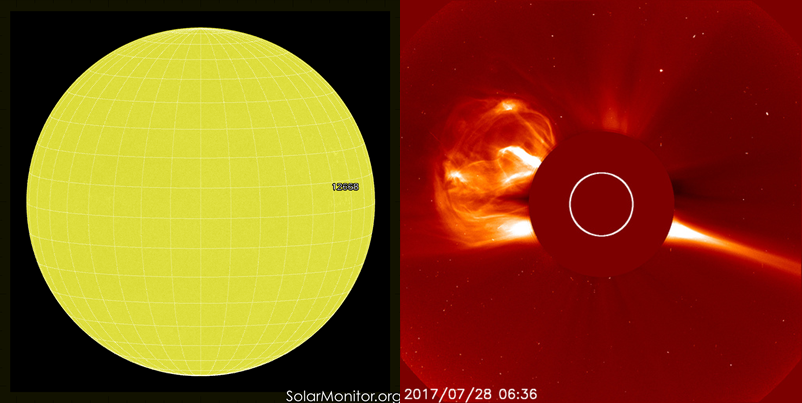
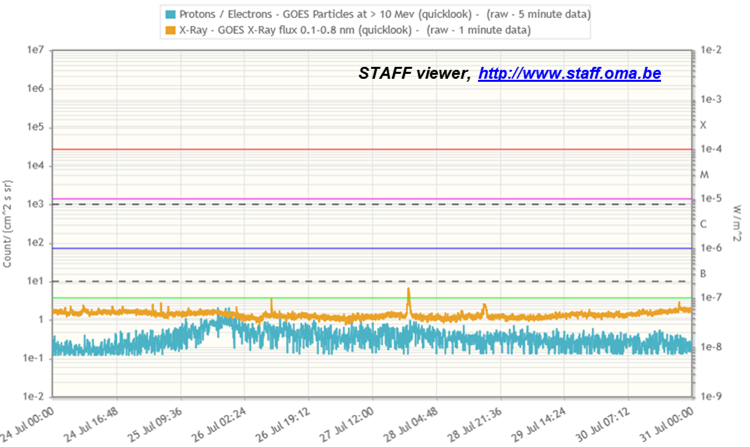
The greater than 10 MeV proton flux was slightly enhanced from late on 24 till 27 July (graph above), probably in response to the strong farside event from NOAA 2665 on 23 July. A maximum of 2 pfu was reached late on 25 July, well below the 10 pfu proton event threshold. In anticipation to NOAA 2665's return on 31 July and increased potential on C-class flares (see annotated GOES13 x-ray image below), the All Quiet Alert was halted on 30 July. A small negative equatorial coronal hole (CH) transited the central meridian from 27 till 29 July.
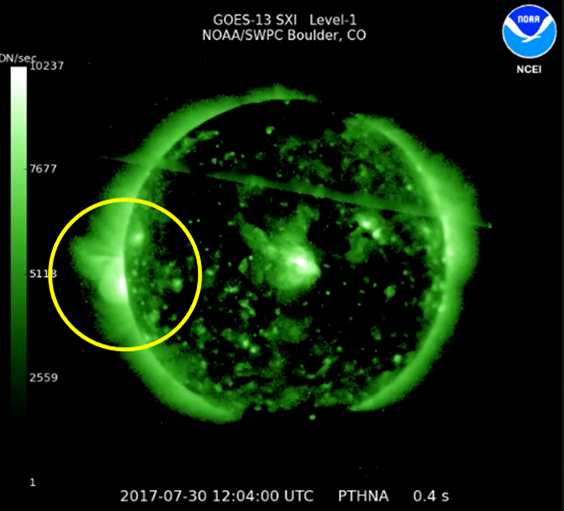
PROBA2 Observations (24 Jul 2017 - 30 Jul 2017)
Solar Activity
Solar flare activity remained very low during the week.
In order to view the activity of this week in more detail, we suggest to go to the following website from which all the daily (normal and difference) movies can be accessed: http://proba2.oma.be/ssa
This page also lists the recorded flaring events.
A weekly overview movie can be found here (SWAP week 383):
http://proba2.oma.be/swap/data/mpg/movies/weekly_movies/weekly_movie_2017_07_24.mp4
Details about some of this week's events, can be found further below.
If any of the linked movies are unavailable they can be found in the P2SC movie repository here:
http://proba2.oma.be/swap/data/mpg/movies/
Thursday Jul 27
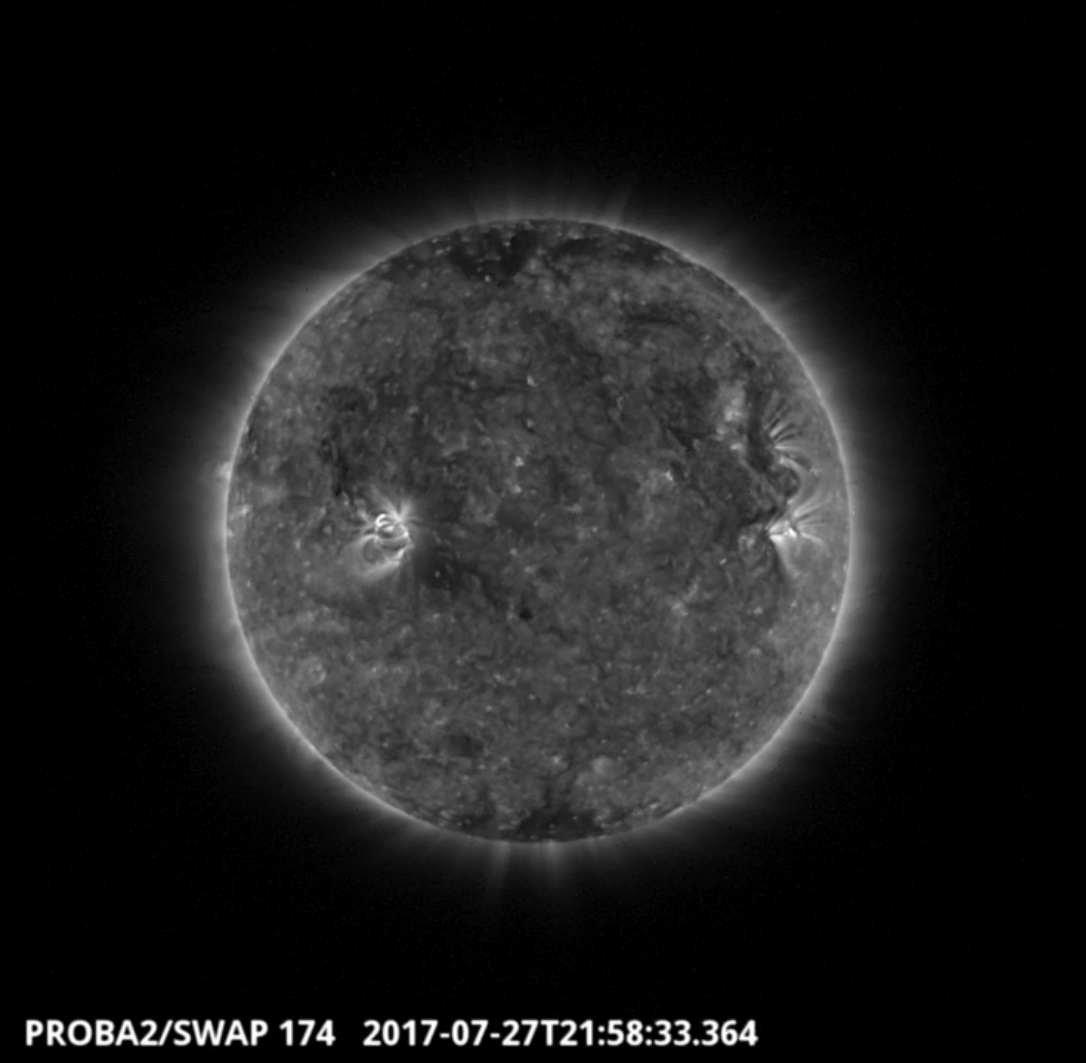
The only flare of the week was a B-class (B1.5) flare on 27-Jul-2017, shown in the eastern hemisphere of the Sun in the SWAP image above at 21:58 UT.
Find a movie of the event here (SWAP movie): http://proba2.oma.be/swap/movies/20170727_swap_movie.mp4
Thursday Jul 28
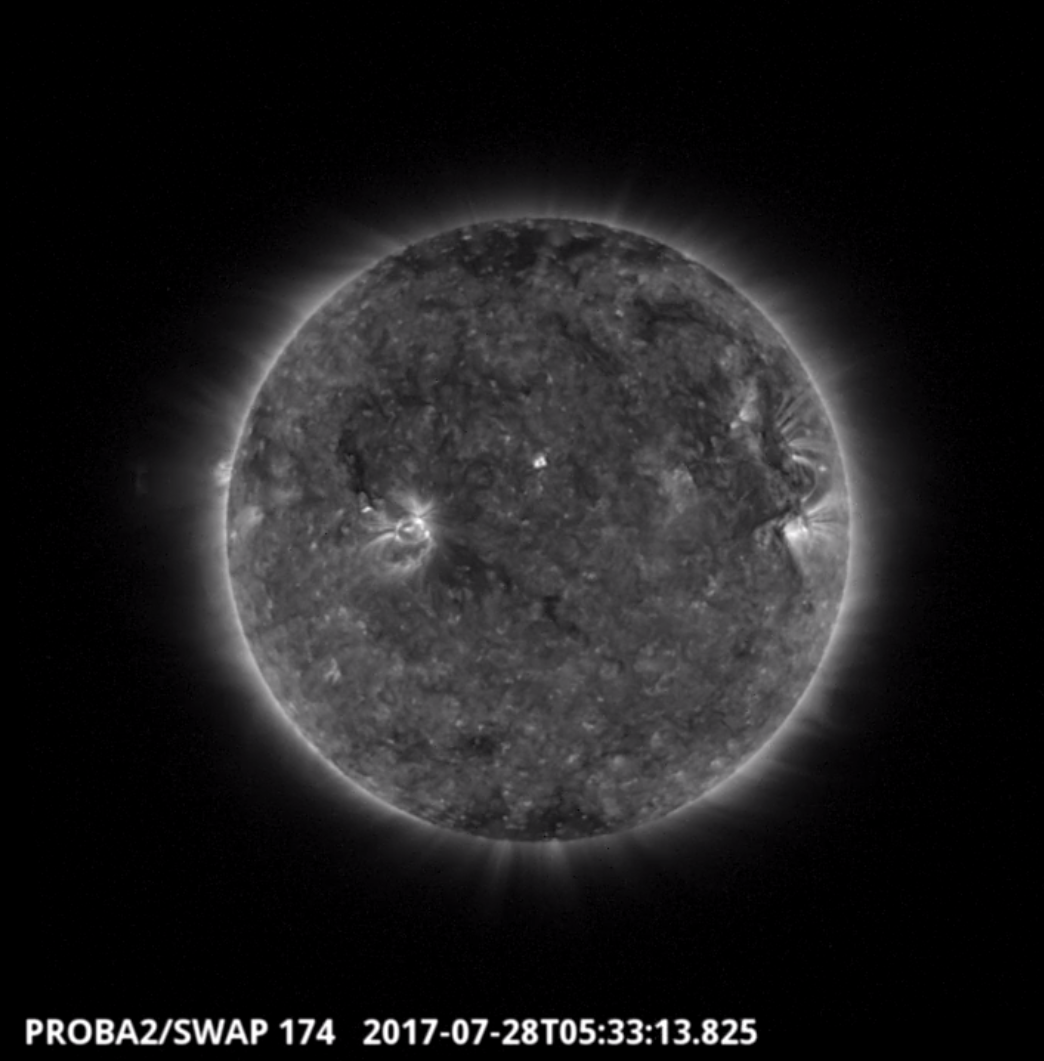
On 28-Jul-2017 at 05:33 UT an eruption off the east limb of the Sun was observed by SWAP, as shown in the image above.
Find a movie of the event here http://proba2.oma.be/swap/movies/20170728_swap_movie.mp4 (SWAP movie) and a difference movie here: http://proba2.oma.be/swap/movies/20170728_swap_diff.mp4
The International Sunspot Number
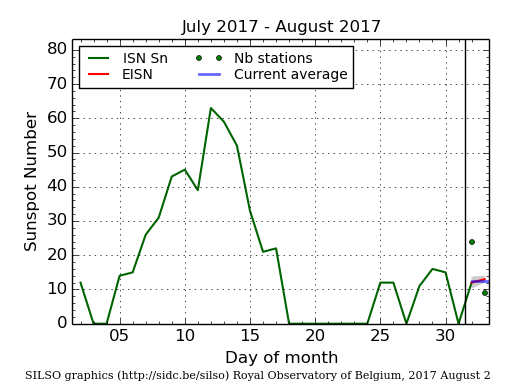
The daily Estimated International Sunspot Number (EISN, red curve with shaded error) derived by a simplified method from real-time data from the worldwide SILSO network. It extends the official Sunspot Number from the full processing of the preceding month (green line). The plot shows the last 30 days (about one solar rotation). The horizontal blue line shows the current monthly average, while the green dots give the number of stations included in the calculation of the EISN for each day.
Review of geomagnetic activity
At the beginning of the week, the earth environment was under the waning influence of high speed stream from the extension of a positive northern polar coronal hole (CH). Wind speed declined from about 700 km/s on 24 July to 450 km/s on 27 July (DSCOVR). Solar wind parameters were at nominal values for the rest of the week, with wind speeds more gradually declining to 350 km/s by the end of the period. Bz oscillated between -6 and +7nT for the entire week, and the interplanetary magnetic field was mostly directed away from the Sun. By 30 July, there was no sign yet of the arrival of the particle stream from the negative equatorial CH.
Some episodes with active geomagnetic conditions were recorded from 24 till 26 July, as Earth was under the influence of the positive CH. For the rest of the week, geomagnetic activity was at quiet to unsettled levels.
A plot with last week's solar wind data as recorded by DSCOVR can be found underneath. It shows respectively the magnetic field strength (white and red curve) and its direction towards or away from the Sun (blue), the density (orange), the speed (yellow) and the temperature (green).
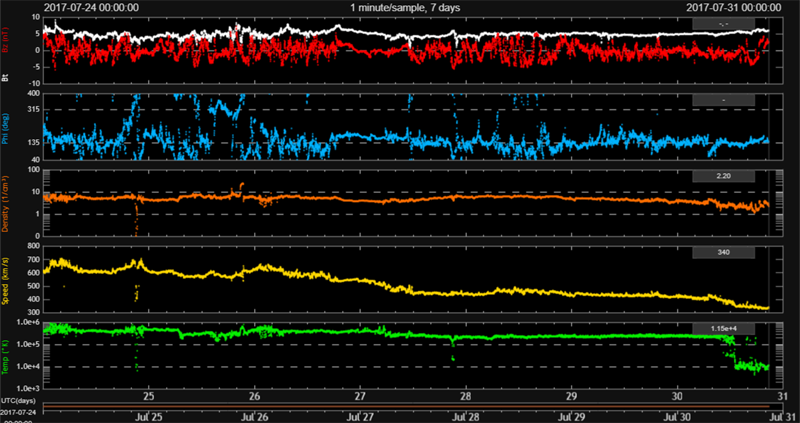
SIDC Space Weather Briefing
The Space Weather Briefing presented by the forecaster on duty from 24 July till 30 July. It reflects in images and graphs what is written in the Solar and Geomagnetic Activity reports. A .wmv version can be found at http://stce.be/movies/SIDCbriefing-2017Jul30.wmv

Review of ionospheric activity (24 Jul 2017 - 30 Jul 2017)
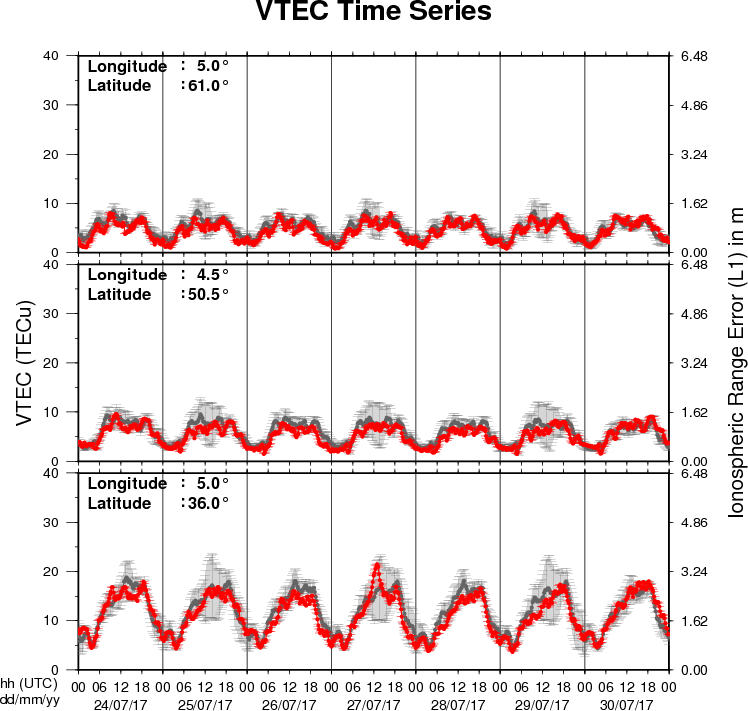
The figure shows the time evolution of the Vertical Total Electron Content (VTEC) (in red) during the last week at three locations:
a) in the northern part of Europe(N61°, 5°E)
b) above Brussels(N50.5°, 4.5°E)
c) in the southern part of Europe(N36°, 5°E)
This figure also shows (in grey) the normal ionospheric behaviour expected based on the median VTEC from the 15 previous days.
The VTEC is expressed in TECu (with TECu=10^16 electrons per square meter) and is directly related to the signal propagation delay due to the ionosphere (in figure: delay on GPS L1 frequency).
The Sun's radiation ionizes the Earth's upper atmosphere, the ionosphere, located from about 60km to 1000km above the Earth's surface.The ionization process in the ionosphere produces ions and free electrons. These electrons perturb the propagation of the GNSS (Global Navigation Satellite System) signals by inducing a so-called ionospheric delay.
See http://stce.be/newsletter/GNSS_final.pdf for some more explanations ; for detailed information, see http://gnss.be/ionosphere_tutorial.php
Future Events
For more details, see http://www.spaceweather.eu/en/event/future
URSI General Assembly in Montreal, Canada
Start : 2017-08-19 - End : 2017-08-26
For the thirty-second time since the inception of URSI, Radio
Scientists from across the world will get together for the URSI
General Assembly and Scientific Symposium. This triennial gathering
will take place from 19th to 26th of August 2017, in Montreal,
Canada. This conference is a unique opportunity to learn about
recent advances in all fields of Radio Science, as covered by all
ten URSI Commissions.
Among the different sessions, please note:
* 'Radio Science for Space Weather'
Conveners: M. Messerotti, V. Pierrard
* 'Remote Sensing and Modeling of the Earth's Plasmasphere
and Plasmapause'
Conveners: A. M. Jorgensen, V. Pierrard, B. Heilig
The abstract deadline is 30 January 2017
Website: http://www.ursi2017.org
2017 Joint IAPSO-IAMAS-IAGA Assembly in Cape Town, South Africa
Start : 2017-08-27 - End : 2017-09-01
The Joint IAPSO-IAMAS-IAGA Assembly, endorsed by the University
of Cape Town and the South African Department of Science and
Technology, will take place from 27 August to 1 September 2017 at
the Cape Town International Convention Centre (CTICC). Several IAGA
and IAMAS sessions are of Space Weather interests as well as the
joint session 'Space Weather throughout the Solar System: Bringing
Data and Models together'.
Website:
http://iapso-iamas-iaga2017.com/index.php
Workshops on Radiation Monitoring for the International Space Station in Torino, Italy
Start : 2017-09-05 - End : 2017-09-07
The Workshop on Radiation Monitoring for the International Space
Station is an annual meeting to discuss the scientific definition
of an adequate radiation monitoring package and its use by the
scientific community on the ISS. Types of instruments and research
topics need to be defined in order to optimise the radiation safety
of the ISS crew.
Website: http://wrmiss.org/
International Workshop on Solar, Heliospheric & Magnetospheric Radioastronomy in Meudon, France
Start : 2017-11-06 - End : 2017-11-10
Jean-Louis Steinbeg has been one of the major pioneers in
radioastronomy. Co-founder of the Nançay Observatory, he
has actively participated to, an inspired a large number of radio
instruments on many international space missions. Jean-Louis
Steinberg is the founder of the Space Radioastronomy laboratory of
the Paris Observatory in 1963. Later on, this laboratory widened
its science interests and became the DESPA (1971) and then the
current LESIA (2002) which is one of the major space sciences
laboratories in France. The aim of this workshop is to cover the
science topics which Jean-Louis Steinberg has promoted during his
career, focusing on Solar, Heliospheric & Magnetospheric
radioastronomy & physics. This will be done by covering both
observations from either ground facilities (NDA, RH, LOFAR, Artemis
etc ...) or space missions (ISSEE, Ulysses, WIND, CLUSTER, STEREO,
CASSINI, JUNO etc ...) and models/theories. A series of invited
talks is also foreseen to cover the new developments in the
discipline which may come with the future facilities such as Solar
Orbiter, Solar Probe Plus, JUICE, JUNO, LOFAR+, SKA etc ....
This workshop will also be the opportunity to remember both the
extraordinary personal & professional lifes of Jean-Louis
Steinberg especially for new generation of scientists. At the
occasion of this workshop it is also expected that the Building 16
(historical Space Sciences building) on the Meudon campus will be
renamed "Building Jean-Louis Steinberg".
Website:
https://jlsworkshop.sciencesconf.org/
European Space Weather Week 14
Start : 2017-11-27 - End : 2017-12-01
The ESWW is the main annual event in the European Space Weather
calendar. It is the European forum for Space Weather as proven by
the high attendance to the past editions. The agenda will be
composed of plenary/parallel sessions, working meetings and
dedicated events for service end-users. The ESWW will again adopt
the central aim of bringing together the diverse groups in Europe
working on different aspects of Space Weather.
Website:
http://www.stce.be/esww14/
